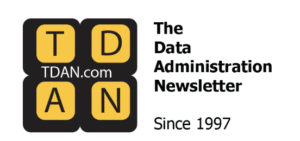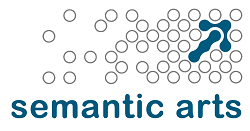Data-Centric: How Big Things Get Done (in IT)
Dave McComb I read “How Big Things Get Done” when it first came out about six months ago.[1] I liked it then. But recently, I read another review of it, and another coin dropped. I’ll let you know what the coin was toward the end of this article, but first I need to give you my … Read more
The New Gist Model for Quantitative Data
Phil Blackwood Every Enterprise can benefit from having a simple, standard way to represent quantitative data. In this blog post, we will provide examples of how to use the new gist model of quantitative data released in gist version 13. After illustrating key concepts, we will look at how all the pieces fit together and … Read more
The Data-Centric Revolution: Best Practices and Schools of Ontology Design
This article originally appeared at The Data-Centric Revolution: Best Practices and Schools of Ontology Design – TDAN.com. Subscribe to TDAN directly for this and other great content! I was recently asked to present “Enterprise Ontology Design and Implementation Best Practices” to a group of motivated ontologists and wanna-be ontologists. I was flattered to be asked, … Read more

DCA Forum Recap: Forrest Hare, Summit Knowledge Solutions
A knowledge model for explainable military AI Forrest Hare, Founder of Summit Knowledge Solutions, is a retired US Air Force targeting and information operations officer who now works with the Defense Intelligence Agency (DIA). His experience includes integrating intelligence from different types of communications, signals, imagery, open source, telemetry, and other sources into a cohesive … Read more

Financial Data Transparency Act “PitchFest”
The Data Foundation (Data Foundation PitchFest) hosted at PitchFest on “Unlocking the vision of the Financial Data Transparency Act” a few days ago. Selected speakers were given 10 minutes to bring their best ideas on how to use the improved financial regulatory information and data. The Financial Data Transparency Act is a new piece of … Read more

DCA Forum Recap: Jans Aasman, Franz
How a “user” knowledge graph can help change data culture Identity and Access Management (IAM) has had the same problem since Fernando Corbató of MIT first dreamed up the idea of digital passwords in 1960: opacity. Identity in the physical world is rich and well-articulated, with a wealth of different ways to verify information on … Read more

How to Take Back 40-60% of Your IT Spend by Fixing Your Data
Creating a semantic graph foundation helps your organization become data-driven while significantly reducing IT spend Organizations that quickly adapt to changing market conditions have a competitive advantage over their peers. Achieving this advantage is dependent on their ability to capture, connect, integrate, and convert data into insight for business decisions and processes. This is the … Read more

DCA Forum Recap: US Homeland Security
How US Homeland Security plans to use knowledge graphs in its border patrol efforts During this summer’s Data Centric Architecture Forum, Ryan Riccucci, Division Chief for U.S. Border Patrol – Tucson (AZ) Sector, and his colleague Eugene Yockey gave a glimpse of what the data environment is like within the US Department of Homeland Security … Read more

HR Tech and The Kitchen Junk Drawer
I often joke that when I started with Semantic Arts nearly two years ago, I had no idea a solution existed to a certain problem that I well understood. I had experienced many of the challenges and frustrations of an application-centric world but had always assumed it was just a reality of doing business. As … Read more

The Data-Centric Revolution: “RDF is Too Hard”
This article originally appeared at The Data-Centric Revolution: “RDF is Too Hard” – TDAN.com. Subscribe to The Data Administration Newsletter for this and other great content! The Data-Centric Revolution: “RDF is Too Hard” By Dave McComb We hear this a lot. We hear it from very smart people. Just the other day we heard someone … Read more

gist Jumpstart
This blog post is for anyone responsible for Enterprise data management who would like to save time and costs by re-using a great piece of modeling work. It updates an earlier blog post, “A brief introduction to the gist semantic model”. A core semantic model, also called an upper ontology, is a common model across … Read more

Data-Centric Revolution: Is Knowledge Ontology the Missing Link?
“You would think that after knocking around in semantics and knowledge graphs for over two decades I’d have had a pretty good idea about Knowledge Management, but it turns out I didn’t. I think in the rare event the term came up I internally conflated it with Knowledge Graphs and moved on. The first tap … Read more

A Knowledge Graph for Mathematics
This blog post is for anyone interested in mathematics and knowledge representation as associated with career progression in today’s changing information eco-system. Mathematics and knowledge representation have a strong common thread; they both require finding good abstractions and simple, elegant solutions, and they both have a foundation in set theory. It could be used as … Read more

The ABCs of QUDT
This blog post is for anyone interested in understanding units of measure for the physical world. The dominant standard for units of measure is the International System of Units, part of a collaborative effort that describes itself as: Working together to promote and advance the global comparability of measurements. While the International System of Units … Read more

Extending an upper-level ontology (like GIST)
Michael Sullivan is a Principle Cloud Solutions Architect at Oracle. Article reprinted with permission (original is here) If you have been following my blogs over the past year or so they you will know I am a big fan of adopting an upper-level ontology to help bootstrap your own bespoke ontology project. Of the available … Read more

The Data-Centric Revolution: Zero Copy Integration
I love the term “Zero Copy Integration.” I didn’t come up with it, it was the Data Collaboration Alliance, that came up with that one. The Data Collaboration Alliance is a Canadian based advocacy group promoting localized control of data along with federated access. What I like about the term is how evocative it is. … Read more

Knowledge Graph Modeling: Time series micro-pattern using GIST
Michael Sullivan is a Principle Cloud Solutions Architect at Oracle. Article reprinted with permission (original is here) For any enterprise, being able to model time series is more than just important, in many cases it is critical. There are many examples but some trivial ones include “Person is employed By Employer” (Employment date-range), “Business has … Read more

Alan Morrison: Zero-Copy Integration and Radical Simplification
Dave McComb’s book Software Wasteland underscored a fundamental problem: Enterprise software sometimes costs 1,000 times more than it ought to. The poster child for cost overruns was highlighted in the book was Healthcare.gov, a public registration system for the US Affordable Care Act, enacted in 2010. By 2018, the US Federal government had spent $2.1 … Read more

The Data-Centric Revolution: Detour/Shortcut to FAIR
The FAIR principles for data sets are gaining traction, especially in the pharmaceutical industry in Europe. FAIR stands for: Findable, Accessible, Interoperable and Reusable. In a world of exponential data growth and ever-increasing silo-ization, the FAIR principles are needed more than ever. In this article, we will first summarize the FAIR principles and describe the typical roadmap to FAIR. … Read more

The Data-Centric Revolution: An Interview with Dave McComb
Are today’s economics of software projects and support inevitable? No. They are a product of the fact that the industry has collectively chosen the application-centric route to implementing new functionality. When every business problem calls for a new application and every new application comes with its own database, what you really get is runaway complexity. … Read more

Six Enterprise Knowledge Graph Anti-Patterns
The truth is that despite the outsider’s perception that the world of technology just keeps getting better, faster and less expensive, over 70% of enterprise digital transformations fail to achieve their objectives (McKinsey, 2019). Most commentary on the subject points the finger at executive priorities, strategic goal-setting and organizational management. But the seldom discussed root cause of … Read more

Semantic Messages
Interfaces and Interactions Too Much Specificity And Not Enough Play I recently saw this tweet and it reminded me about something I’ve wanted to think and talk about. Satnam continues configuration management has not had the attention enjoyed by academic research for languages and networking, as well as language and networking innovations in industry. I don’t think … Read more

The Data-Centric Revolution: OWL as a Discipline
Many developers pooh-pooh OWL (the dyslexic acronym for the Web Ontology Language). Many decry it as “too hard,” which seems bizarre, given that most developers I know pride themselves on their cleverness (and, as anyone who takes the time to learn OWL knows, it isn’t very hard at all). It does require you to think … Read more

The Greatest Sin of Tabular Data
We recently came across this great article titled “The greatest sin of tabular data”. It is an excellent summary of the kind of work we do for our clients and how they benefit. You can read it at The greatest sin of tabular data · A blog @ nonodename.com The journey of capturing the meaning … Read more

Software Development process expressed in a Knowledge Graph
More times than not we receive pushback on the use of RDF (the standard model for data exchange on the web) being difficult. However, the simplicity of triplestores (Subject – Predicate – Object) and logically composing queries with the written language make this form ideal for technical business users, capability owners, and data scientists alike. … Read more

Resisting the Temptation of Fused Edges
Fused Edges If you are doing domain modeling and using a graph database you might be tempted to use fused edges. You see them around the semantic web. But you should resist the temptation. What In a graph database a fused edge occurs when a domain modeler uses a single edge where a node and … Read more

The Data-Centric Revolution: Headless BI and the Metrics Layer
Read more from Dave McComb in his recent article on The Data Administration Newsletter. “The data-centric approach to metrics puts the definition of the metrics in the shared data. Not in the BI tool, not in code in an API. It’s in the data, right along with the measurement itself.” Link: The Data-Centric Revolution: Headless … Read more

How to SPARQL with tarql
To load existing data into a knowledge graph without writing code, try using the tarql program. Tarql takes comma-separated values (csv) as input, so if you have a way to put your existing data in csv format, you can then use tarql to convert the data to semantic triples ready to load into a knowledge … Read more

Incremental Stealth Legacy Modernization
I’m reading the book Kill it with Fire by Marianne Bellotti. It is a delightful book. Plenty of pragmatic advice, both on the architectural side (how to think through whether and when to break up that monolith) and the organizational side (how to get and maintain momentum for what are often long, drawn-out projects). So … Read more

SHACL and OWL
There is a meme floating around out in the internet ether these days: “Is OWL necessary, or can you do everything you need to with SHACL?” We use SHACL most days and OWL every day and we find it quite useful. It’s a matter of scope. If you limited your scope to replacing individual applications, … Read more
The Data-Centric Revolution: Avoiding the Hype Cycle
Gartner has put “Knowledge Graphs” at the peak of inflated expectations. If you are a Knowledge Graph software vendor, this might be good news. Companies will be buying knowledge graphs without knowing what they are. I’m reminded of an old cartoon of an executive dictating into a dictation machine: “…and in closing, in the future … Read more
Smart City Ontologies: Lessons Learned from Enterprise Ontologies
For the last 20 years, Semantic Arts has been helping firms design and build enterprise ontologies to get them on the data-centric path. We have learned many lessons from the enterprise that can be applied in the construction of smart city ontologies. What is similar between the enterprise and smart cities? They both have thousands … Read more
A Slice of Pi: Some Small Scale Experiments with Sensor Data and Graphs
There was a time when RDF and triplestores were only seen through the lens of massive data integration. Teams went to great extremes to show how many gazillion triples per second their latest development could ingest, and large integrations did likewise with enormous datasets. This was entirely appropriate and resulted in the outstanding engineering achievements … Read more
The Data-Centric Revolution: Fighting Class Proliferation
One of the ideas we promote is elegance in the core data model in a Data-Centric enterprise. This is harder than it sounds. Look at most application-centric data models: you would think they would be simpler than the enterprise model, after all, they are a small subset of it. Yet we often find individual application … Read more
Achieving Clarity in your Data Ecosystem
Achieving clarity in your data ecosystem is more difficult than ever these days. With false news, cyber-attacks, social media, and a consistent blitz of propaganda – how does one sort it all out? Even our data and information practices have suffered from this proliferation (data warehouse, data lake, data fabric, data mesh … this is … Read more
DCAF 2021: Third Annual Data-Centric Architecture Forum Re-Cap
Written by Peter Winstanley The Data-Centric Architecture Forum was a success! If growth of participants is an indicator of the popularity of an idea, then the Third Annual Data-Centric Architecture Forum is reflecting a strong increase in popularity, for this year over 230 participants joined together for a three-day conversation. This is a huge increase on … Read more
Telecom Frameworx Model: Simplified with “gist”
We recently recast large portions of the telecom Frameworx Information Model into an Enterprise Ontology using patterns and reusable parts of the gist upper ontology. We found that extending gist with the information content of the Frameworx model yields a simple telecom model that is easy to manage, federate, and extend, as described below. Realizing … Read more
The 90s Are Over, Let’s Stop Basing Capital Cost Decisions on Lagging Indicators
Let’s Stop Basing Capital Cost Decisions on Lagging Indicators. Remember the good old days of emerging digital technology? Accessing information through a dial-up internet connection. Saving data to floppy discs or CDs. Sending emails to have them printed for storage. Mobile connectivity was new, exciting, and… slow compared to what we have today. In the … Read more
A Data-Centric Approach to Managing Customer Data
by Phil Blackwood, Ph.D. Without a doubt every business needs to have a clear idea of who its customers are and would love to have a 360 degree view of each customer. However, this customer data is typically scattered across hundreds of applications, its meaning is embedded in code written years ago, and much of … Read more
Dispose, Delete, and Discard: Keep your Enterprise Data Tidy Part 3
Those who are familiar with Marie Kondo know that she is a ruthless disposer. If you’ve read parts one and two of this series, you know that the process is more nuanced than just “throw it all away,” but we’ve come to the point in the process where it’s important to focus on discarding. If … Read more
The Data-Centric Revolution: The Role of SemOps (Part 1)
We’ve been working on something we call “SemOps” (like DevOps but for Semantic Technology + IT Operations). The basic idea is how can we create a pipeline to go from proposed enterprise ontology or taxonomy enhancements to “in-production” as frictionlessly as possible. As so often happens, when we shine the Semantic Light on a topic … Read more
A Data Engineer’s Guide to Semantic Modelling
While on her semantic modelling journey and as a Data Engineer herself, Ilaria Maresi encountered a range of challenges. There was not one definite source where she could quickly look things up, many of the resources were extremely technical and geared towards a more experienced audience while others were too wishy-washy. Therefore, she decided to … Read more
A Brief Introduction to the gist Semantic Model
Phil Blackwood, Ph.D. It’s no secret that most companies have silos of data and continue to create new silos. Data that has the same meaning is often represented hundreds or thousands of different ways as new data models are introduced with every new software application, resulting in a high cost of integration. By contrast, the … Read more
Sharing Ontologies Globally To Speed Science And Healthcare Solutions
The COVID-19 pandemic is a clear example of how healthcare practitioners require swift access to enormous amounts of diverse information to efficaciously treat patients. They must synthesize individual data (vital signs, clinical history, demographics, and more) with rapidly evolving knowledge about COVID-19 and make decisions relevant to the conditions from which specific patients suffer.ners rely … Read more
Setting the Stage for Success Part 2
Envisioning Your Dream System with the Marie Kondo Method Before you begin gathering your belongings, discarding, or reorganizing, Marie Kondo asks you to envision your dream lifestyle. She insists that this is the critical first step to ensuring success with her method, and she provides some guidance on how to do so and examples from … Read more
A Mathematician and an Ontologist walk into a bar…
The Ontologist and Mathematician should be able to find common ground because Cantor introduced set theory into the foundation of mathematics, and W3C OWL uses set theory as a foundation for ontology language. Let’s listen in as they mash up Cantor and OWL … Ontologist: What would you like to talk about? Mathematician: Anything. Ontologist: … Read more
The Data-Centric Revolution: Data-Centric vs. Centralization
We just finished a conversation with a client who was justifiably proud of having centralized what had previously been a very decentralized business function (in this case, it was HR, but it could have been any of a number of functions). They had seemingly achieved many of the benefits of becoming data-centric through decentralization: all … Read more
Does your Data Spark Joy? Part 1
Why is Marie Kondo so popular for home organization? Marie Kondo released her book, “The Life-Changing Magic of Tidying up,” almost ten years ago and has since gained much notoriety for motivating millions of people to de-clutter their homes, offices, and lives. Some people are literally buried in their possessions with no clear way to … Read more
The Data-Centric Revolution: The Sky is Falling (Let’s Make Lemonade)
Recently IDC predicted that IT spending will drop by 5% due to the COVID-19 pandemic.[1] Last week, Gartner went further by predicting that IT spending would drop by 8% or $300 Billion.[2] (Expect a prediction bidding war.) Both were consistent: highest hit areas would be devices, followed by IT service and enterprise software. The predicted $100 billion … Read more
The Data-Centric Hospital
‘The Graceful Adaption of St Frances Xavier Cabrini Hospital since 1948. This post has been updated to reflect the current corona virus crisis. Joe Pine and Kim Korn authors of ‘Infinite Possibility: Creating Customer Value on the Digital Frontier’ say the coronacrisis will change healthcare for the better. Kim points out that although it is 20 years … Read more
Structure-First Data Modeling: The Losing Battle of Perfect Descriptions
In my last article I described Meaning-First data modeling. It’s time to dig into its predecessor and antithesis, which I call Structure-First data modeling, specifically looking at how two assumptions drive our actions. Assumptions are quite useful since they leverage experience without having to re-learn what is already known. It is a real time-saver. Until … Read more
Graph Database Superpowers: Unraveling the back-story of your favorite graph databases
The graph database market is very exciting, as the long list of vendors continues to grow. You may not know that there are huge differences in the origin story of the dozens of graph databases on the market today. It’s this origin story that greatly impacts the superpowers and weaknesses of the various offerings. While … Read more
The Data-Centric Revolution: The Role of SemOps (Part 2)
In our previous installment of this two-part series we introduced a couple of ideas. First, data governance may be more similar to DevOps than first meets the eye. Second, the rise of Knowledge Graphs, Semantics and Data-Centric development will bring with it the need for something similar, which we are calling, “SemOps” (Semantic Operations). Third, when you … Read more
DCAF 2020: Second Annual Data-Centric Architecture Forum Re-Cap
Last year, we decided to call the first annual Data Centric Architecture Conference a Forum which resulted in DCAF. It didn’t take long for attendees to start calling the event “decaf” but they were equally quick to point out that the forum was anything but decaf. We had a great blend of presentations ranging from discussions … Read more
Decades, Planets and Marriage
Google ontologist, Denny Vrandečić started a vigorous thread on the question of what constitutes a decade. See for example, the article: “People Can’t Even Agree On When The Decade Ends”. This, is a re-emergence of the question from 20 years ago on whether the new millennium will/did start on January 1 of 2000 or 2001.This … Read more
Meaning-First Data Modeling, A Radical Return to Simplicity
Person uses language. Person speaks language. Person learns language. We spend the early years of life learning vocabulary and grammar in order to generate and consume meaning. As a result of constantly engaging in semantic generation and consumption, most of us are semantic savants. This Meaning-First approach is our default until we are faced with … Read more
Time to Rethink Master and Reference Data
Every company contends with data quality, and in its pursuit they often commit substantial resources to manage their master and reference data. Remarkably, quite a bit of confusion exists around exactly what these are and how they differ. And since they provide context to business activity, this confusion can undermine any data quality initiative. Here … Read more
Facet Math: Trim Ontology Fat with Occam’s Razor
At Semantic Arts we often come across ontologies whose developers seem to take pride in the number of classes they have created, giving the impression that more classes equate to a better ontology. We disagree with this perspective and as evidence, point to Occam’s Razor, a problem-solving principle that states, “Entities should not be multiplied … Read more
Property Graphs: Training Wheels on the way to Knowledge Graphs
I’m at a graph conference. The general sense is that property graphs are much easier to get started with than Knowledge Graphs. I wanted to explore why that is, and whether it is a good thing. It’s a bit of a puzzle to us, we’ve been using RDF and the Semantic Web stack for almost … Read more

